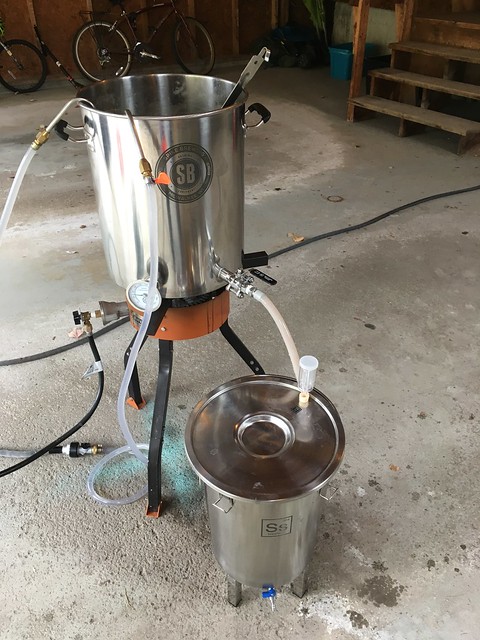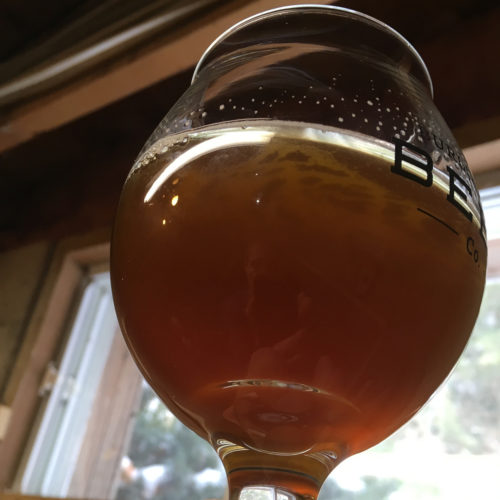Homebrew #75: Extinction Event
¶ by Rob FrieselBrewing a big ol’ barleywine is a homebrewing right of passage, right? Something you simply must attempt at some point? And so here was my first stab at it — Extinction Event:
The main motivation for Extinction Event was the temptation inherent in the challenge of brewing a high-gravity beer. Having tried and failed to brew an Imperial Stout, an American Barleywine seemed like the next obvious choice for such a Big Beer™. I don’t drink a lot of these, but I do drink a couple each year — usually as a holiday treat or to commemorate an occasion.
So I started working out a recipe, and eventually settled on one. And then a friend came along (half-jokingly?) with the perfect name. Which of course meant that I needed to throw in a little Comet hops just to drive the pun home.
Brew Day
I started setting up the night before. I collected my water, filtering it through a carbon filter and collecting it in HDPE buckets. Each one got half a crushed Campden tablet and their brewing salts. (Let’s get as much chlorine out of there as we can, am I right?) After that I staged the gear and got myself off to bed for what would be my last garage brew of the year.
The next morning, I milled my grain and got the flame going for the strike water. I mashed in at 152°F and… well… held my breath at just how full that kettle was. Seventy-five minutes later, I pulled the bag and did my post-mashing science: 6.8 gallons of wort at 1.072.
I got the flame going again for the boil and followed along with my formula’s schedule. An ounce and a half of Galena at 60 minutes. One pound of brown sugar at 30 minutes. Two and a half teaspoons of yeast nutrient and half a teaspoon of Irish moss at 15 minutes — and an ounce each of Amarillo and Comet. As the timer went off, I started running cold water through my chiller; when the wort hit 180°F, I added two ounces each of Comet and Ekuanot, and another ounce of Amarillo.
Time for some post-boil science: boiled down to about 5.75 gallons, and an original gravity of 1.091. 1
Fermentation
With the wort chilled to 65°F, I decanted (most of) the supernatant off the yeast and pitched about 400 ml of slurry and the remaining supernatant. I set the temperature controller to 66±1°F. I had steady bubbles in the blow-off bucket after about 17 hours.
The temperatures and bubble activity held steady for several days. I took the first sample for gravity at +54 hours. I sighted 15.5°Bx in the refractometer; BeerSmith converted that to 1.045 but it’s typically a few points off, so it was probably more like 1.049.
At this point, it was smelling hoppy a.f. — practically IPA hoppy. I felt my brow furrow here and thought to myself well geez this could pass for almost any style in Category 22.
I started bumping up the temperature after another day, bringing it up to 68±1°F over three more days.
I took another gravity reading (hydrometer this time), saw that it had come down to 1.017. I pulled it from the fermentation chamber and fined it with gelatin. 2 I let the finings do their thing for a few days (I left town for a little trip, so it was easy to be patient) and racked the beer to a keg afterward.
I did a “mostly closed” transfer from the Brew Bucket into a keg, getting about 4.75 gallons of finished beer which — having pulled just one more sample for gravity — had finished at 1.015 for 10.2% ABV.
I chilled it down to 40°F and then put it on CO₂ at 12 PSI for about a week. The first pour was pretty hazy/cloudy, 3 but the next two were looking a lot better.
Overall Impressions
A pro-brewer friend of mine remarked that his rubric for judging a barleywine is that it should drink about 2% lower than its actual ABV. And this one seemed to hit those marks for him.
AROMA. Hop-forward with tropical and citrus notes dominating. Strong tangerine; strong pineapple; moderate grapefruit; low underripe mango. Blackberry note (likely an ester expression?) but faint. Malt character is a supportive but background player here; moderate toasted light bread. Hints of fig and red currant as it warms. Alcohol is detectable but not overwhelming.
APPEARANCE. Burnished copper color. Gold highlights held up to the light. Ivory head stands about 1cm with average retention but some persistent lacing. Average clarity; noticeable chill haze. Very fine, slow-rising bubbles.
FLAVOR. Malt character presents as moderate toasted bread with supportive notes of caramel and a black cherry jam. Light amounts of toffee mid-palate. Finishes semi-sweet with significant warming. Less hop character in the flavor than on the nose; presents more like marmalade and the fruit puree on a pineapple upside down cake. Retronasal impression is of grapefruit pith. Medium but firm bitterness. Balanced finish leans toward malt impressions. Long semi-sweet aftertaste.
MOUTHFEEL. Medium-full body. Medium-low carbonation. Low amounts of creaminess. Significant alcohol warming, but not hot. No detectable astringency.
OVERALL IMPRESSION. A hoppy, warming, and decidedly high-alcohol beer. Relatively smooth despite the high alcohol, and arguably deceptive in strength. Considering the hop presence on the nose, I would expect more of it on the palate as well. Contrariwise, the malt expression on the palate does not translate to the aroma. In that sense, it’s slightly out-of-balance, though not unpleasant. And while not a thin beer, it does seem a little light for the style and could have its body boosted somewhat. We’ll see how it does in competition, but I judged it in the Very Good range. That said, I wonder if it would score better as an American Strong Ale?
Were I to make this one again, I would consider dialing back the late hop schedule slightly so that it doesn’t overwhelm the malts in the aroma. I would also consider boosting the bitterness somewhat — I don’t think the end result was aggressive enough for the style. Again, while the result wasn’t a light-bodied beer, it would benefit from some more weight; perhaps a maltodextrin addition during the boil?
Overall, I’m pleased with how this one turned out and/but/also filing this one under the heading of “Not Bad For a First Attempt”. These early pours have been tasty though, and surprisingly not harsh in terms of alcohol or “hop burn”. Now to get a case worth into bottles for cellaring…
Recipe
The all-grain (BIAB) recipe for Extinction Event is as follows:
Water Chemistry
Starting with the Champlain Water District profile as a base:
- 0.10 g/gal. calcium chloride
- 0.16 g/gal. sodium chloride (salt)
- 0.58 g/gal. Epsom salt
- 0.76 ml/gal. 88% lactic acid
| Ca | Mg | Na | SO₄ | Cl⁻ | HCO₃⁻ |
|---|---|---|---|---|---|
| 60 | 19 | 24 | 71 | 56 | 66 |
Mash Grains
- 10 lb. Thomas Fawcett’s Golden Promise malt
- 5 lb. Briess 2-row brewer’s malt
- 12 oz. Briess 40L caramel malt
- 8 oz. Dingeman’s Special B malt
- 8 oz. Briess Victory malt
- 4 oz. Briess Carapils malt
Fermentables
1 lb. light brown sugar (30 min. late addition)
Hop Schedule
- 1½ oz. Galena (60 min.)
- 1 oz. Amarillo (15 min.)
- 1 oz. Comet (15 min.)
- 2 oz. Comet (steep/whirlpool ≤180°F)
- 2 oz. Ekuanot (steep/whirlpool ≤180°F)
- 1 oz. Amarillo (steep/whirlpool ≤180°F)
Yeast
Wyeast 1332 Northwest Ale (propagate 2 packages in a 1800 ml starter)
Brew Day
- Collect 32.30 qt. water and heat to 162.2°F. Mash in; hold at 152.1°F for 75 minutes. No mash out.
- Remove filter bag from water. Squeeze filter bag to extract as much liquid as possible for wort. No sparge. Pre-boil volume should be 6.83 gallons.
- Bring to a boil. Boil for 60 minutes; follow hop schedule as described above.
- Cool to 65°F as rapidly as possible. Post-boil volume should be approx. 5 gallons.
- Aerate wort; pitch 1332 yeast from starter.
- Start fermentation at 66±1°F.
Beyond Brew Day
- Allow fermentation to complete (approx. 2 weeks) at approx. 66±1°F. Raise temperature to 68±2°F as activity slows to encourage complete attenuation.
- Fine with gelatin to encourage clearing of the beer.
- Transfer to a keg and force carbonate to 2.3 vols (10-12 PSI at 40°F for 5 days should be enough).
- Enjoy!
Details
Extinction Event, an American Barleywine by Tilde Gravitywerks
| Original Gravity | 1.091 |
| Final Gravity | 1.015 |
| ABV | 10.2% |
| Attenuation | 82.4% |
| IBU | 80 |
| SRM | 16 |
| Links | Untappd Flickr |
- Full disclosure: I’d planned on an O.G. of 1.100 — however I had also read multiple times that I should expect to see decreased efficiency in a high-gravity mash. So in part shooting for 1.100 was a hedge against that decreased efficiency. And while I was a little disappointed to not hit those numbers, it was partly expected. And let’s face it, 1.091 isn’t a bad place to start.[↩]
- Again: I’ve heard conflicting things about how well gelatin finings work without a cold crash, but it seemed to work well-enough last time that I was willing to give it another go.[↩]
- To be honest, that very first pour just looked gross. I tried to convince myself that maybe I could pass it off as a hazy double IPA or something, but the color was too dark to be appetizing, but not dark enough to hide the haze. It tasted just fine, but it was not appealing to the eyes.[↩]
About Rob Friesel
Software engineer by day. Science fiction writer by night. Weekend homebrewer, beer educator at Black Flannel, and Certified Cicerone. Author of The PhantomJS Cookbook and a short story in Please Do Not Remove. View all posts by Rob Friesel →2 Responses to Homebrew #75: Extinction Event
Pingback: Homebrew #76: Lupulin-Industrial Complex | found drama




Leave a Reply